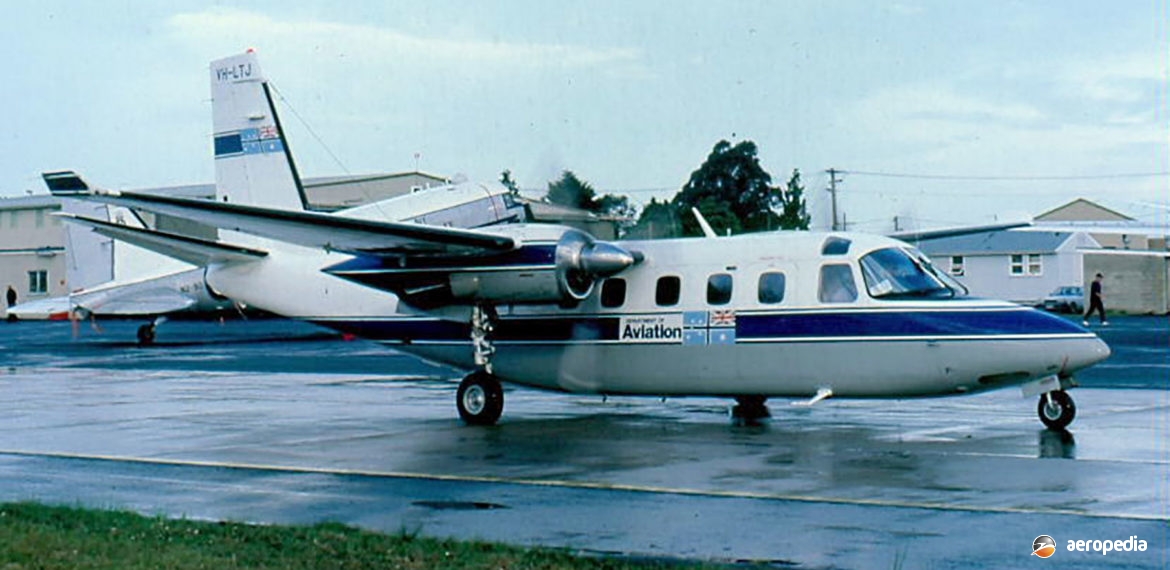Photograph:
Gulfstream Commander / Aero Commander 1000 (Model 695A) VH-LTJ (c/n 96069) at ‘HMAS Albatross’ Nowra, NSW in October 1986 (David C Eyre)
Country of origin:
United States of America
Description:
Business and executive aircraft
Power Plant:
Two 612 kw (820 shp) Garrett AiResearch TPE 331-10-501K turboprops
Specifications:
- Wingspan: 15.89 m (52 ft 1½ in)
- Length: 13.1 m (42 ft 11¾ in)
- Height: 4.55 m (14 ft 11½ in)
- Wing area: 25.95 m² (279.37 sq ft)
- Max cruising speed at 6,700 m (22,000 ft): 571 km/h (355 mph)
- Economical cruising speed at 10,670 m (32,500 ft): 474 km/h (295 mph)
- Initial rate of climb: 853 m/min (2,800 ft/min)
- Range with max payload and 45 mins reserve: 2,429 km (1,510 miles)
- Range with max fuel: 3,855 km (2,395 miles)
- Empty weight: 3,270 kg (7,210 lb)
- Loaded weight: 5,080 kg (11,200 lb)
History:
The prototype of the Gulfstream Commander Series 1000 (or 695B) was flown for the first time on 12 May 1980 and deliveries of production aircraft began in July of the following year. The 1000 differed from the earlier aircraft in the series in having an increase in the size of the cabin, this being achieved by moving the cabin pressure bulkhead back towards the rear of the aircraft, and an increase in power.
A multi-mission version of the 1000 was made available to customers also, this being able to be converted quickly from an executive layout to all-cargo or medevac configuration, and a new cargo door was introduced. In the executive role the 1000 normally carried a pilot and six passengers, but provision could be made for a maximum of 11 passengers in a high-density arrangement.
In early 1983 the Australian Department of Aviation (DOA) (as it then was) ordered five examples of the Commander 1000, registered as Commander 695A Jetprop 1000s, from the Australian distributor, Civil Flying Services in Melbourne, VIC. The first aircraft VH-LTI (c/n 96063) was handed over to the department at Bethany in Oklahoma on 31 May 1983. All told, another five were obtained during the following three years, being VH-LTJ (c/n 96069); VH-LTK (c/n 96075); VH-LTM (c/n 96208); VH-LTN (c/n 96078); and VH-LTO (c/n 96085).
The Australian aircraft were multi-mission models for search-and-rescue, medical evacuation, airport flight inspection, air-route survey, and training missions to enable departmental officers to maintain flying skills on modern turboprop aircraft. They replaced seven of the department’s older aircraft, which were sold, these including a Piper Aztec, two Aero Commander 680s, and four Swearingen Merlin IIIBs. These Commander aircraft had a special pylon-type device designed by DOA and Gulfstream Corporation engineers which could be fitted to the rear fuselage to enable emergency supplies to be dropped. These departmental aircraft were withdrawn from service in 1993, replaced and sold; and only one example remained on the Australian register.

